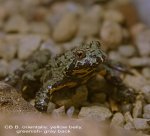DocZelop
New member
Hi everyone,
looks like it's the mating season ! So, as a lot of breeders, I've had my first success at breeding FBT this year... I've got a dozen toadlets, that metamorphed about two weeks ago...
Everything is fine, and they're eating fruitflies like there's no tomorrow
However, they remain quite brownish on the back (though the parents are bright green) and yellowish on the belly...
Does anyone know if the colouring appears gradually (both back and belly) or if I have to supplement the food ? For now, I'm dusting the fruitflies with Reptivit (not sure it's a good choice), about once every week...
So, if you have any advice on the supplement I should add to the food, that would be very much appreciated !
Thanks in advance
looks like it's the mating season ! So, as a lot of breeders, I've had my first success at breeding FBT this year... I've got a dozen toadlets, that metamorphed about two weeks ago...
Everything is fine, and they're eating fruitflies like there's no tomorrow
However, they remain quite brownish on the back (though the parents are bright green) and yellowish on the belly...
Does anyone know if the colouring appears gradually (both back and belly) or if I have to supplement the food ? For now, I'm dusting the fruitflies with Reptivit (not sure it's a good choice), about once every week...
So, if you have any advice on the supplement I should add to the food, that would be very much appreciated !
Thanks in advance




